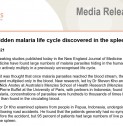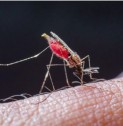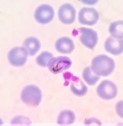Dr Steven Kho
Senior Research Fellow
Qualifications:
PhD, Charles Darwin University, 2019; Bachelor of Science (Honours in Biochemistry), University of Western Australia, 2010; Bachelor of Science (Molecular Biology & Biotechnology), University of Western Australia, 2009;
Research Topic:
The hidden splenic Plasmodium reservoir as a target to reduce global malaria burden
Location:
Darwin - Royal Darwin Hospital campus
Biography:
Steven grew up in Indonesia and came to Australia in 2007 to complete his undergraduate degree at the University of Western Australia in Perth.
In 2012, Steven relocated to Darwin and joined Menzies as a research assistant in the Global and Tropical Health team, focusing on malaria research.
In 2019, Steven graduated with a PhD from Charles Darwin University and Menzies. His current research focuses on understanding the pathophysiological role of the spleen and innate host components such as platelets and neutrophils in human malaria. His field studies in Papua have found that platelets directly attack and kill parasites in the blood of malaria patients, which may lead to the identification of novel therapeutic targets to treat malaria or alleviate disease severity. Steven’s research has informed treatment policy for splenectomised patients living in endemic areas of Indonesia who are at higher risk of vivax and falciparum malaria. He recently discovered that the human spleen is the major reservoir for P. falciparum and P. vivax parasites in chronic malaria and received the prestigious Am. Soc. Trop. Med. Hyg. Young Investigator award for his achievements. Steven is currently working to dissect the splenic reservoir’s fundamental biology to inform the development of new and improved malaria control strategies.
Research Themes
- The human spleen as a reservoir for Plasmodium species: discovery of the cryptic endosplenic lifecycle
- Mechanisms underlying splenic accumulation of malaria parasites and its endosplenic lifecycle
- Splenic Plasmodium dormancy and reduced drug susceptibility: implications in malaria elimination
- Evaluation of peripheral markers to estimate the hidden splenic reservoir in human malaria
- Mechanisms of splenomegaly, splenic red cell congestion and its contribution to malarial anemia
- Splenic mechanisms driving and/or maintaining malaria tolerance of innate cells
- The hidden splenic Plasmodium falciparum and P. vivax reservoir in Africa: prevalence, magnitude and seasonal variations
- Role of the human spleen in erythropoiesis and reticulocyte biology
- Risks of malaria and other clinical outcomes after splenectomy in malaria endemic areas: Informing policy for management of splenectomised patients
- The roles of platelets, red cell interactions, extracellular traps and host immune cells in human malaria
- Extracellular traps in children with non-cystic fibrosis bronchiectasis
- Leonardo L., Kenangalem E., Poespoprodjo J.R., Noviyanti R., Price R.N., Anstey N.M., Minigo G., Kho S. Increased circulating myeloid-derived suppressor cells in vivax malaria and severe falciparum malaria. Malar J, 2022 Sep 8;21(1):255
- Kho S., Anstey N.M., Barber B.E., Piera K.A., William T., Kenangalem E., McCarthy J.S., Jang I.K., Domingo G.J., Britton S., Grigg M.J. Diagnostic performance of a 5-plex malaria immunoassay in regions co-endemic for Plasmodium falciparum, P. vivax, P. knowlesi, P. malariae and P. ovale. Sci Rep, 2022 May 4;12(1):7286.
- Kho S., Qotrunnada L., Leonardo L., Andries B., Wardani P.A.I., Fricot A., Henry B., Hardy D., Margyaningsih N.I., Apriyanti D., Puspitasari A.M., Prayoga P., Trianty L., Kenangalem E., Chretien F., Safeukui I., Del Portillo H.A., Fernandez-Becerra C., Meibalan E., Marti M., Price R.N., Woodberry T., Ndour P.A., Russell B.M., Yeo T.W., Minigo G., Noviyanti R., Poespoprodjo J.R., Siregar N.C., *Buffet P.A., *Anstey N.M. Hidden biomass of intact malaria parasites in the human spleen. New Engl J Med, 2021 May; 384(21):2067-2069.
- Kho S., Qotrunnada L., Leonardo L., Andries B., Wardani P.A.I., Fricot A., Henry B., Hardy D., Margyaningsih N.I., Apriyanti D., Puspitasari A.M., Prayoga P., Trianty L., Kenangalem E., Chretien F., Brousse V., Safeukui I., Del Portillo H.A., Fernandez-Becerra C., Meibalan E., Marti M., Price R.N., Woodberry T., Ndour P.A., Russell B.M., Yeo T.W., Minigo G., Noviyanti R., Poespoprodjo J.R., Siregar N.C., *Buffet P.A., *Anstey N.M. Evaluation of splenic accumulation and colocalization of immature reticulocytes and Plasmodium vivax in asymptomatic malaria: a prospective human splenectomy study. PLOS Med, 2021 May; 18(5):e1003632.
- Kho S., Minigo G., Andries B., Leonardo L., Prayoga P., Poespoprodjo J.R., Kenangalem E., Price R.N., Woodberry T., Anstey N.M., Yeo W.Y. Circulating neutrophil extracellular traps and neutrophil activation are increased in proportion to disease severity in human malaria. The Journal of Infectious Diseases, June 2019, 219(12):1994-2004.
- Kho S., Andries B., Poespoprodjo J.R., Commons R.J., Shanti P.A.I., Kenangalem E., Douglas N.M., Simpson J.A., Sugiarto P., Anstey N.M., Price R.N. High risk of Plasmodium vivax malaria following splenectomy in Papua, Indonesia. Clinical Infectious Diseases, January 2019, 68(1):51-60.
- Kho S., Barber B.E., Johar E., Andries B., Poespoprodjo J.R., Kenangalem E., Piera K.A., Ehmann A., Price R.N., William T., Woodberry T., Foote S., Minigo G., Yeo T.W., Grigg M.J., Anstey N.M.*, McMorran B.J.* [*equal last]. Platelets kill circulating parasites of all major Plasmodium species in human malaria. Blood, September 2018, 132:1332-1344
- Kho, S., Marfurt, J., Handayuni, I., Pava, Z., Noviyanti, R., Kusuma, A., et al. (2016). Characterization of blood dendritic and regulatory T cells in asymptomatic adults with sub-microscopic Plasmodium falciparum or plasmodium vivax infection. Malaria Journal, 15, 328.
- Wirjanata, G., Handayuni, I., Prayoga, P., Apriyanti, D., Chalfein, F., Sebayang, B.F., et al. (2015). Quantification of Plasmodium ex vivo drug susceptibility by flow cytometry. Malaria Journal ,14(1), 417.
- Kho, S., Marfurt, J., Noviyanti, R., Kusuma, A., Piera, K., Burdam, F.H., et al. (2015). Preserved dendritic cell HLA-DR expression and reduced regulatory T cell activation in asymptomatic plasmodium falciparum and P. vivax infection. Infection and Immunity, 83(8), 3224.

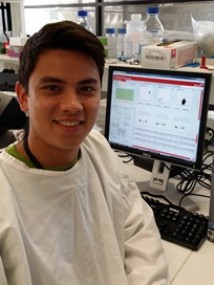
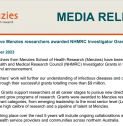
.jpg&w=123&h=126)


.jpg&w=123&h=126)

